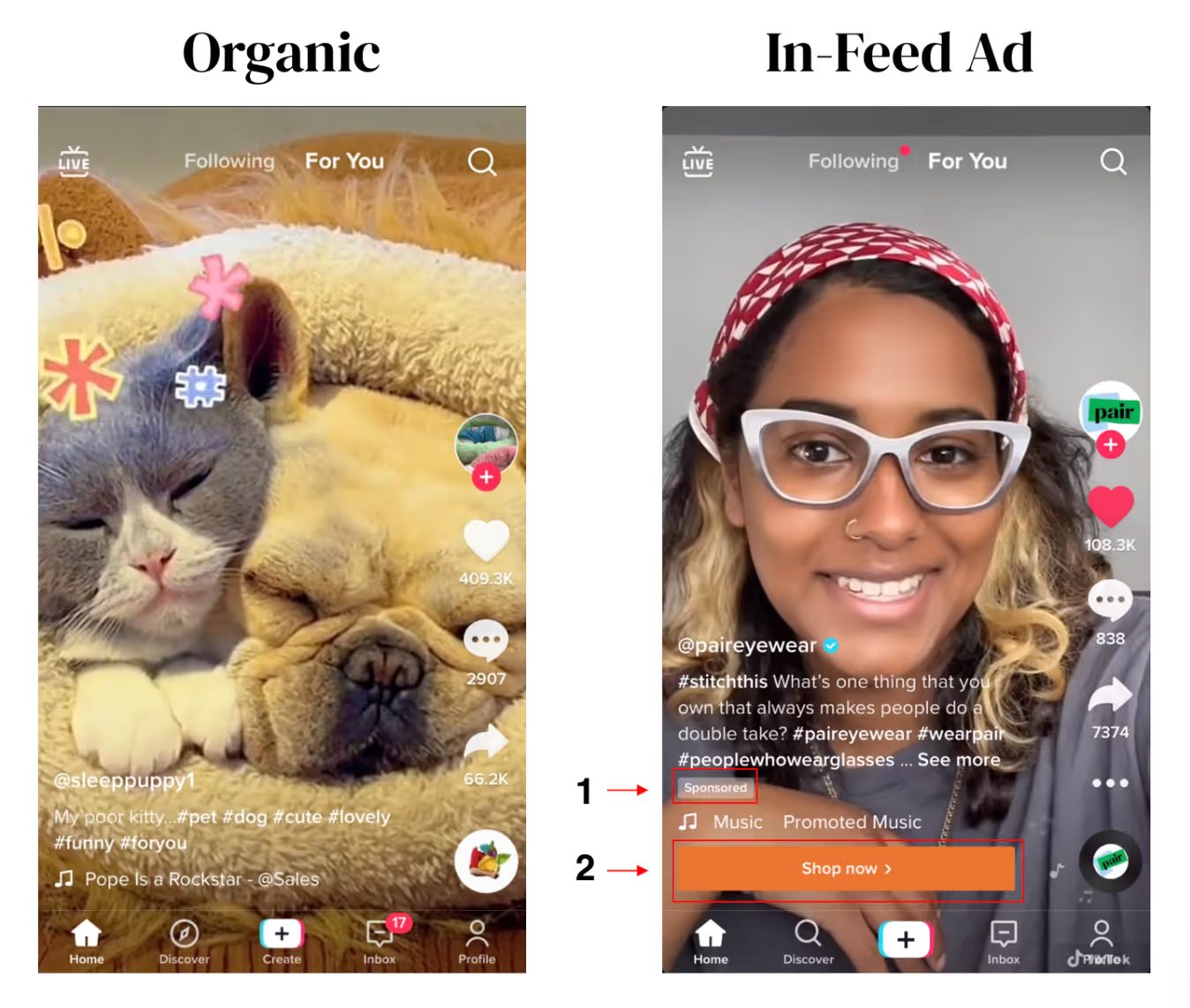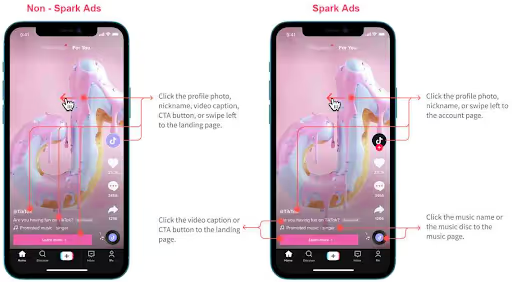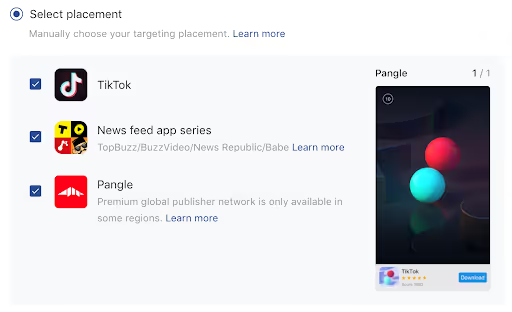
Conversation

🥳 Feedback Received!
Thanks for taking a moment to share your thoughts — it genuinely helps us make each chapter sharper.
What happens next:
- Your feedback goes straight to our product team.
- We’ll use it to refine lessons, clarify examples, and make the program even more useful.
Appreciate you helping make this program better for everyone.
Ready for your next challenge? 👇
TikTok Ad Types
Since you'll be using a self-serve ad account (like Facebook Ad Manager), you'll have two types to choose from: In-Feed ads and Spark ads.
TikTok has a few other ad types you're likely familiar with (e.g., dynamic product ads, collection ads, and carousel ads). However, these formats are only available to TikTok-managed accounts or via region-specific placements outside the TikTok app. The self-serve platform is still pretty new, and TikTok is slowly testing these features on a small scale before eventually releasing them to all ad accounts.
In-Feed ads
In-Feed ads are the dominant ad type on TikTok. These ads are auction-enabled and serve in the For You feed in-between organic posts.
From a user perspective, two main elements distinguish an In-Feed ad from an organic TikTok.

- Sponsored tag: Ads feature a 'Sponsored' tag in the bottom left-hand corner of the screen, above the music track.
- Call-to-action: CTA button is visible after 3 seconds.
Here are a few more things to know about In-Feed ads:
- Keep copy minimal and let the creative shine: TikTok is a video-dominant platform and body copy is minimal (truncated after 48 characters). The most engaging TikTok ads make full use of audio and visual effects to hook users and keep them watching to the end. Make sure to complement interesting visuals with short, strong CTAs and captions that highlight your top value props.
- All ads are required to use an audio track. Using the right music in conjunction with eye-catching transitions keeps people watching.
- All ads are required to use an audio track. Using the right music in conjunction with eye-catching transitions keeps people watching.
- Fifteen seconds or less: Ads can last up to 60 seconds, but the sweet spot is between 9 - 15 seconds. Most users will only see the thumbnail of your ad and decide whether to swipe away or keep watching. This happens in a split second, which means you need a solid hook to capture their interest immediately, then let your content carry it through to the end.
- Comments-on: TikTok users are vocal and use the comments section of ads to share their thoughts, leave feedback (good and bad), and ask questions about the promoted product. Make sure to leave the comments setting on since engagement can help propel your ads in the auction, thus gaining exposure to broader audiences. Furthermore, positive comments are social proof for potential customers. And if you start seeing negative comments, you can use negative keyword filters to block them out.
Spark ads
Spark ads can be a huge driver of conversions. They help brands’ ads feel significantly more organic and natural within the platform, which is the key to success on TikTok.
Spark ads are TikTok's version of boosted posts, or "whitelisted" ads on Facebook—your ad looks like it's coming from an influencer, but it's coming from your ads account.
Unlike regular boosted posts, when companies pay to amplify their organic content, Spark ads function like ads—they're served through TikTok's ad auction, with full audience targeting and optimization abilities, and performance is tracked through TikTok Ads Manager.
Two ways to set these up:
- Deploy Spark ads through your TikTok business profile: Create Spark ads using organic posts from the public TikTok account linked to your Ad Manager account.
- Deploy Spark ads through an influencer's profile: Create Spark ads using organic posts that TikTok Creators have authorized you to use in your advertising. The Spark ad is promoted from the creator's page and displayed with their handle, with no visible branding.
- With most forms of influencer marketing, companies pay influencers to create content and promote it to their audience. With Spark ads, you're still commissioning influencer content, but you, the advertiser, have complete control over the targeting and optimization settings.

Why use Spark ads over In-Feed ads?
We recommend testing In-Feed ads and Spark ads (both types) to see what performs best, but here are the key advantages of Spark ads:
- Social proof: Consumers are more likely to trust a product recommendation from a (seemingly) impartial third party than from a brand's self-promotion. With Spark ads, businesses can leverage everyday creators and influencers alike to help promote products, in a non-promotional way, with complete control over the message and targeting.
- Minimal branding: Unlike In-Feed ads, Spark ads don't display the "sponsored" tag—a dead giveaway. Instead, Spark ads disguise all branding elements, making your ads look much more organic. That's a massive advantage on a platform whose users aren't receptive to traditional ads.
- Spark ads benefit influencers: Influencers are more likely to work with brands that offer to put money into Spark ads using the influencers' account. As a brand, this lets you tap into the influencer's existing audience and new audiences simultaneously. And influencers benefit because their accounts get significantly more reach, and they grow in influence as a result.
- Passive organic growth: When people see an ad, a fraction of them will want to visit your business profile, and if they like what they see, follow you. There's no way for users to do this via In-Feed ads, short of typing your brand name in the search bar manually. On the other hand, Spark ads give viewers more options to learn more about your brand and connect. Viewers can:
- Tap the CTA button or video caption to visit your landing page
- Tap your profile picture or display name, or swipe left to view your TikTok profile
- Tap the '+' sign on your profile picture to follow your account
Insight: Use Spark ads to kickstart passive organic growth
Spark ads are clever because you can save the asset to your profile as an organic post every time you launch one. Since ads and organic posts are so similar in appearance, it's reasonable to post "copies'' of your ads to your public profile to help kickstart passive organic growth.
If the content is good (as evidenced by the amount of ad engagement), TikTok may boost it to new audiences organically via the For You Page, which can help you acquire more followers and generate interest in your products—you're killing two birds with one stone.
Plan on using both In-Feed ads and Spark ads, testing each ad type in tandem to see which format performs best. We'll show you how to set up both types in the Project section at the end of this module.
Alternative ad types
TikTok has a few premium ad options, but they're significantly more expensive and better suited for brand awareness campaigns over customer acquisition. What's more, these ad types are only available to managed agency accounts, not self-serve accounts.
Here's a brief description of TikTok's premium ads:
- AR Branded Effects: Like Snapchat and Instagram's ad products, TikTok Branded Effects let businesses create shareable stickers, filters, and AR effects to help drive engagement in their promotions.
- TopView: TopView ads are 60-second ads that play immediately when users open the app. TopView ads offer guaranteed reach to brands who can afford them ($65k minimum per day and up to $2 million on a major shopping holiday).
- Sponsored Hashtag Challenge Ads: Companies can sponsor hashtag challenges that appear next to the organic hashtag challenges on TikTok’s Discover Page. These can cost up to $500k and are used to generate awareness and encourage virality through digital word of mouth and user-generated content.
Note: TikTok is testing all kinds of features in several different markets right now, including those product-focused ad types we mentioned at the start. That means certain features and ad types may be unavailable to you. Nevertheless, In-Feed ads and Spark ads are available to all self-serve accounts. And all features we highlight in this playbook are open to everyone.
What placement option should you use?
TikTok has three different placement options. Depending on the countries you do business in, you have the option to place ads on TikTok, Pangle, and News App.

Each placement option has different creative and format specifications. For instance, you can't conveniently deploy a TikTok ad creative across multiple placements without making significant adjustments. For that reason, and considering this module is about TikTok ads, specifically, we recommend sticking with TikTok as your sole placement.
Read TikTok's documentation for more information on placements and available locations.


